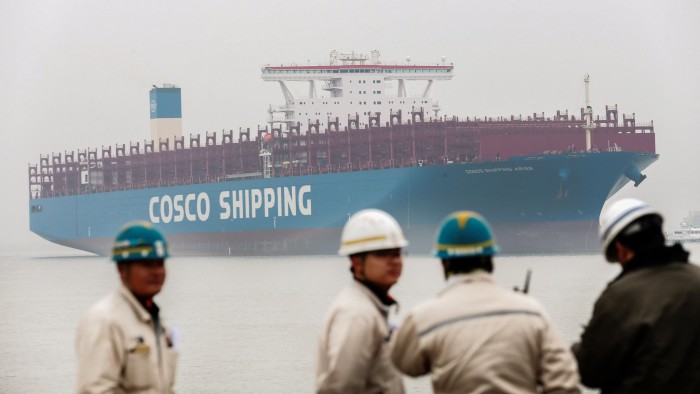Davos: Protection and demography in emerging markets threaten growth engine

Roula Khalaf, Editor of the FT, selects her favourite stories in this weekly newsletter.
The emerging world is emerging once again. After several years of economic upheaval, with big emerging markets such as Brazil, Russia and Nigeria in recession and the biggest of all, China, provoking fears of a “hard landing”, economic growth is now almost universal across the emerging world.
The question is: will it last?
Investors seem to think so. After a five year bear market, the MSCI Emerging Market Index is up 75 per cent since early 2016, far outpacing the 50 per cent rise in developed market stocks over the same period.
Macroeconomic data appear to vindicate such optimism. While growth among advanced economies as a group is predicted to slow from 2.3 per cent last year to 2.2 per cent in 2018, according to the World Bank, growth in emerging and developing economies should rise from 4.3 per cent to 4.5 per cent.
Nevertheless, many analysts warn that the emerging world’s outlook is far from uniformly rosy.
“In the short term, the data are looking pretty good and it’s hard to make a case for a sharp reduction in emerging markets growth in the first quarter,” says Neil Shearing, chief emerging markets economist at Capital Economics, a consultancy. However, he warns that “a downturn is closer than many people expect”. Indeed, Capital Economics expects it to come this year, with growth in the group of emerging markets it monitors slowing from 4.4 per cent last year to 4.2 per cent in 2018 and 4 per cent the year after.
Mr Shearing argues that the recent novelty of synchronised growth across emerging markets has distracted attention from the fact that they remain a deeply heterogenous group. While the likes of Brazil and Russia are in the early stages of the economic cycle, smaller countries in central and eastern Europe, for example, are much further along. Growth in China is slowing as the government backs away from fiscal stimulus and tries to cool the country’s overheated property market.
While growth may be widespread, Mr Shearing notes, it is not especially powerful. Capital Economics calculates that emerging markets will contribute about 2.5 percentage points to global growth of 3.4 per cent this year, an improvement on recent years but much less than their contribution of 4 percentage points to global growth of 5 per cent back in 2010.
Trade data, too, while encouraging in the short term, also give reason for caution. On the positive side, says Adam Slater, chief economist at Oxford Economics, a consultancy, is the fact that the emerging world, which as recently as 2015 was a drag on the growth in global trade, now accounts for more than half of it. One reason is the rebound in commodity prices over the past two years, which has improved the terms of trade of commodity exporters, making it cheaper for them to import capital goods from developed countries and use them to improve infrastructure and productivity.
But Mr Slater agrees with Mr Shearing that the upturn in trade and growth, while widespread for now, does not mark any lasting change in direction. “I don’t think there’s anything structural going on,” he says. “This is largely a cyclical story.”
Indeed, Oxford Economics believes global trade growth is in structural decline. One possible cause is a plateau in the rate of globalisation: the rise of global supply chains may have reached its limit and might even be in reverse. While this is bad for trade, it is not necessarily bad for economic activity.
A more pernicious possible cause of slowing trade growth, says Mr Slater, is creeping protectionism. Measuring the influence of either cause is all but impossible, he says, while pointing to “a definite lack of multilateral liberalisation. Since China joined the World Trade Organization [in December 2001] we have had more or less nothing.”
Figures from the Global Trade Alert, which monitors trade policy worldwide, suggest protectionism is indeed on the rise, with an increase in the use of “harmful interventions” over the past three years. Yet Simon Evenett, professor of international trade and economic development at the University of St Gallen in Switzerland, who also oversees the GTA, says import barriers are far from the only threat to trade and economic growth. He points to the increasing use of export subsidies, especially among emerging markets.
He says this is visible in falling prices of traded goods: while the volume of world trade has risen almost steadily since the global financial crisis, prices of traded goods rose at first but then fell from mid-2011 and, despite some recovery in the past two years, remain 16 per cent below their peak.
“If volumes are up but prices are not rising so fast, it shows that exporters are having to cut their prices against firms receiving subsidies,” Prof Evenett adds. “It makes you worry about the longer-term prospects for emerging market exporters.”
There are also demographic reasons to worry about how much longer the world can rely on emerging markets as a driver of global growth. Mr Slater notes that workforces in the emerging world were growing at about 2 per cent a year 15 years ago, he notes, but the pace has since fallen to less than 1 per cent. Oxford Economics expects it to fall to zero by 2025 and to turn negative a decade later. Emerging markets will no longer compensate for falling workforce growth in the developed world, where the pace has already hit zero.
Comments